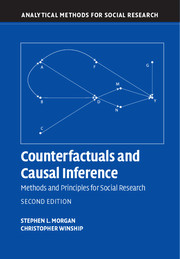Book contents
- Frontmatter
- Dedication
- Contents
- List of Figures
- List of Tables
- Acknowledgments for First Edition
- Acknowledgments for Second Edition
- I Causality and Empirical Research in the Social Sciences
- II Counterfactuals, Potential Outcomes, and Causal Graphs
- 2 Counterfactuals and the Potential Outcome Model
- 3 Causal Graphs
- III Estimating Causal Effects by Conditioning on Observed Variables to Block Back-Door Paths
- IV Estimating Causal Effects When Back-Door Conditioning Is Ineffective
- V Estimation When Causal Effects Are Not Point-Identified by Observables
- VI Conclusions
- References
- Index
3 - Causal Graphs
Published online by Cambridge University Press: 05 December 2014
- Frontmatter
- Dedication
- Contents
- List of Figures
- List of Tables
- Acknowledgments for First Edition
- Acknowledgments for Second Edition
- I Causality and Empirical Research in the Social Sciences
- II Counterfactuals, Potential Outcomes, and Causal Graphs
- 2 Counterfactuals and the Potential Outcome Model
- 3 Causal Graphs
- III Estimating Causal Effects by Conditioning on Observed Variables to Block Back-Door Paths
- IV Estimating Causal Effects When Back-Door Conditioning Is Ineffective
- V Estimation When Causal Effects Are Not Point-Identified by Observables
- VI Conclusions
- References
- Index
Summary
In his 2009 book titled Causality: Models, Reasoning, and Inference, Judea Pearl lays out a powerful and extensive graphical theory of causality. Pearl's work provides a language and a framework for thinking about causality that differs from the potential outcome model presented in Chapter 2. Beyond the alternative terminology and notation, Pearl (2009, section 7.3) shows that the fundamental concepts underlying the potential outcome perspective and his causal graph perspective are equivalent, primarily because they both encode counterfactual causal states to define causality. Yet, each framework has value in elucidating different features of causal analysis, and we will explain these differences in this and subsequent chapters, aiming to convince the reader that these are complementary perspectives on the same fundamental issues.
Even though we have shown in the last chapter that the potential outcome model is simple and has great conceptual value, Pearl has shown that graphs nonetheless provide a direct and powerful way of thinking about full causal systems and the strategies that can be used to estimate the effects within them. Some of the advantage of the causal graph framework is precisely that it permits suppression of what could be a dizzying amount of notation to reference all patterns of potential outcomes for a system of causal relationships. In this sense, Pearl's perspective is a reaffirmation of the utility of graphical models in general, and its appeal to us is similar to the appeal of traditional path diagrams in an earlier era of social science research. Indeed, to readers familiar with path models, the directed graphs that we will present in this chapter will look familiar.
- Type
- Chapter
- Information
- Counterfactuals and Causal InferenceMethods and Principles for Social Research, pp. 77 - 102Publisher: Cambridge University PressPrint publication year: 2014
- 8
- Cited by

